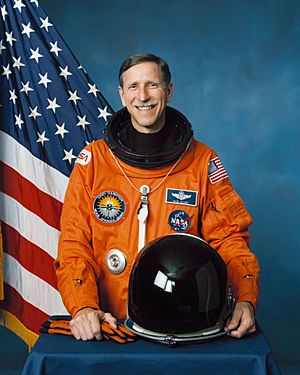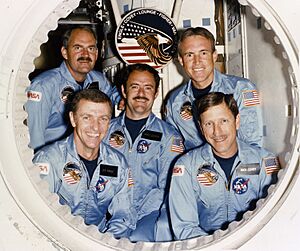Richard O. Covey facts for kids
Quick facts for kids
Richard Covey
|
|
|---|---|
 |
|
| Born |
Richard Oswalt Covey
August 1, 1946 Fayetteville, Arkansas, U.S.
|
| Awards | Distinguished Flying Cross |
| Space career | |
| NASA astronaut | |
| Rank | Colonel, USAF |
|
Time in space
|
26d 21h 9m |
| Selection | NASA Group 8 (1978) |
| Missions | STS-51-I STS-26 STS-38 STS-61 |
|
Mission insignia
|
|
| Retirement | August 1, 1994 |
Richard Oswalt Covey, born on August 1, 1946, is a retired officer from the United States Air Force. He was also a NASA astronaut and is now a member of the United States Astronaut Hall of Fame. He spent over 26 days in space across four different missions.
Contents
Early Life and Education
Richard Covey was born in Fayetteville, Arkansas. He grew up in Fort Walton Beach, Florida. In 1964, he finished high school there. He then went to the United States Air Force Academy. He earned a degree in Engineering Science in 1968. Later, he got a Master of Science degree in Aeronautics and Astronautics from Purdue University in 1969.
Military Career
From 1970 to 1974, Covey was a fighter pilot for the U.S. Air Force. He flew planes like the F-100 Super Sabre and A-7 Corsair II. He completed 339 combat missions during two tours in Southeast Asia.
Between 1975 and 1978, he worked at Eglin Air Force Base in Florida. There, he was a test pilot for F-4 Phantom II and A-7D aircraft. He also directed tests for electronic warfare systems on the F-15 Eagle. In total, he has flown over 5,700 hours in more than 30 different types of aircraft.
NASA Career
NASA chose Richard Covey to be an astronaut candidate in January 1978. He officially became an astronaut in August 1979. He flew on four space missions: STS-51-I in 1985, STS-26 in 1988, STS-38 in 1990, and STS-61 in 1993. He has spent more than 646 hours in space. He was the last person from his astronaut class (the 1978 NASA Group 8) to make his first spaceflight.
Before the first flight of the Space Shuttle, he helped with the Shuttle's engineering and testing. He also flew a T-38 jet as a chase pilot for the second and third Shuttle flights. He was part of the support crew for the first working Shuttle flight, STS-5.
Covey also worked as a spacecraft communicator (CAPCOM) in Mission Control. He spoke to astronauts during missions STS-5, 6, 61-B, 61-C, and 51-L. He was the one who gave the command, "Space Shuttle Challenger, go at throttle up" just before the Space Shuttle Challenger incident. In 1989, he led NASA's Space Flight Safety Panel. He also held other important roles in the NASA Astronaut Office.
Space Flights
STS-51-I Mission
His first mission was STS-51-I. He was one of five crew members. The mission launched from Kennedy Space Center, Florida, on August 27, 1985. During this seven-day flight, the crew launched three communication satellites. They also successfully repaired a broken SYNCOM IV-3 satellite in space. This repair was special because it involved the first time an astronaut manually grabbed and released a satellite during a spacewalk. The mission lasted 170 hours. The Space Shuttle Discovery orbited Earth 112 times before landing in California on September 3, 1985.
STS-26 Mission
Next, Covey was the pilot on STS-26. This was the first Space Shuttle flight after the Challenger accident. The five-person crew launched from Kennedy Space Center on September 29, 1988. They were aboard the Discovery. The mission lasted 97 hours. During this time, they successfully launched the TDRS-C satellite. They also worked on eleven other experiments, including two designed by students. The Discovery completed 64 orbits before landing in California on October 3, 1988.
STS-38 Mission
On STS-38, Covey was the commander of a five-person crew. They launched at night from Kennedy Space Center on November 15, 1990. During the five-day mission, the crew carried out operations for the United States Department of Defense. After orbiting Earth 80 times in 117 hours, Covey landed the Space Shuttle Atlantis at Kennedy Space Center on November 20, 1990. This was the first time a Shuttle landed in Florida since 1985.
STS-61 Mission
For his fourth flight, Covey commanded a crew of seven on the Space Shuttle Endeavour. This was the STS-61 mission, which was all about servicing and repairing the Hubble Space Telescope (HST). STS-61 launched at night from Kennedy Space Center on December 2, 1993. During the 11-day flight, the HST was captured and fixed. Four astronauts performed a record five space walks to restore it to full power. After traveling over 4.4 million miles in 163 orbits, Covey landed the Endeavour at night at Kennedy Space Center on December 13, 1993.
After NASA
Richard Covey retired from NASA and the Air Force on August 1, 1994. He is married and has two grown daughters. After the Space Shuttle Columbia accident in 2003, Covey helped lead a commission. This group worked to get the Space Shuttle fleet flying again, starting with the STS-114 mission.
In 2005, Covey received the Distinguished Eagle Scout Award from the Boy Scouts of America. He became an Eagle Scout in 1960. In January 2006, Covey became the Chief Operating Officer of United Space Alliance. He later became the chief executive officer in September 2007. Covey retired from United Space Alliance in March 2010.
Covey also appeared on an episode of the TV show Home Improvement. He and the Hubble repair crew were on the show's fictional segment, Tool Time. They showed some of the tools they used in space.
Special Honors and Awards
Covey has received many awards for his service. These include the Defense Distinguished Service Medals, the Defense Superior Service Medal, and the Legion of Merit. He also earned five Air Force Distinguished Flying Crosses and 16 Air Medals.
From NASA, he received the NASA Distinguished Service Medal and four NASA Space Flight Medals. He is a Distinguished Graduate of the U.S. Air Force Academy. He was also named the Outstanding Graduate of the U.S. Air Force Test Pilot School.
Covey has been inducted into several halls of fame. These include the Astronaut Hall of Fame, the Arkansas Aviation Hall of Fame, and the Choctawhatchee High School Hall of Fame. He is also a Fellow of the American Institute of Aeronautics and Astronautics. In 1994, Covey and his STS-61 crew received the National Space Club's Goddard Trophy. They also received the National Aeronautics Association's Collier Trophy for 1993.


